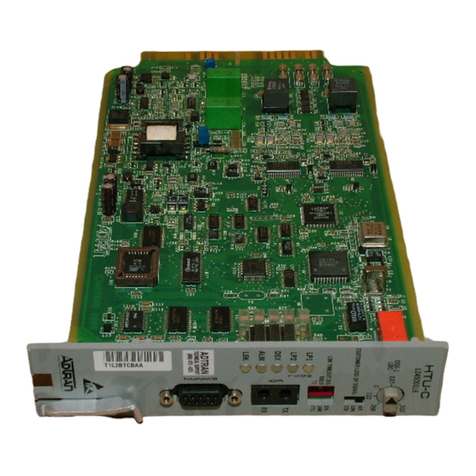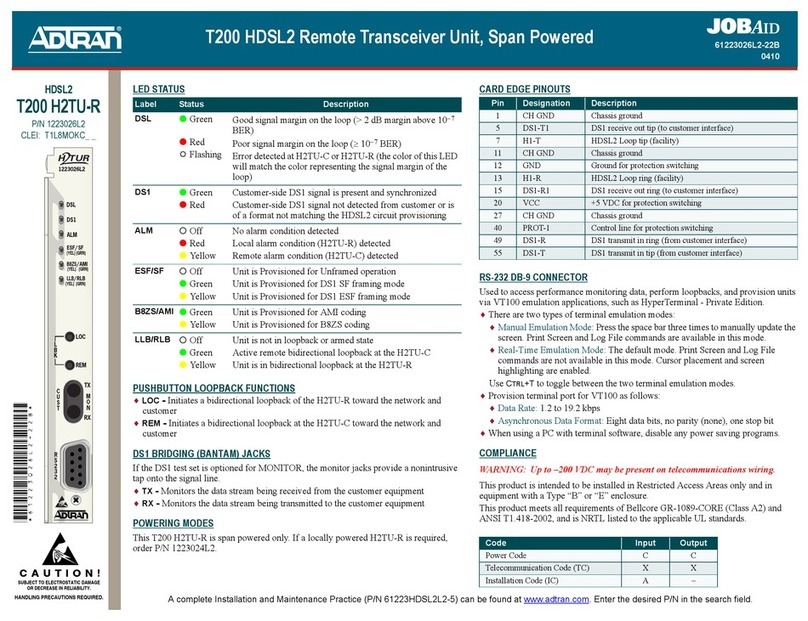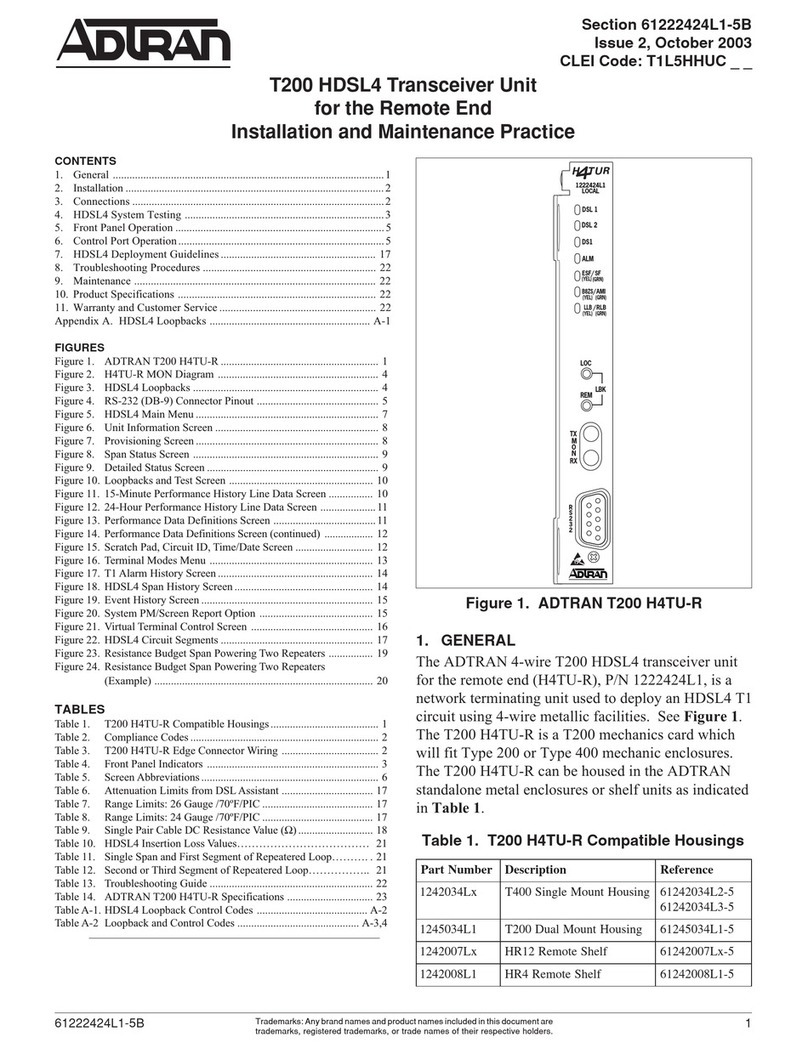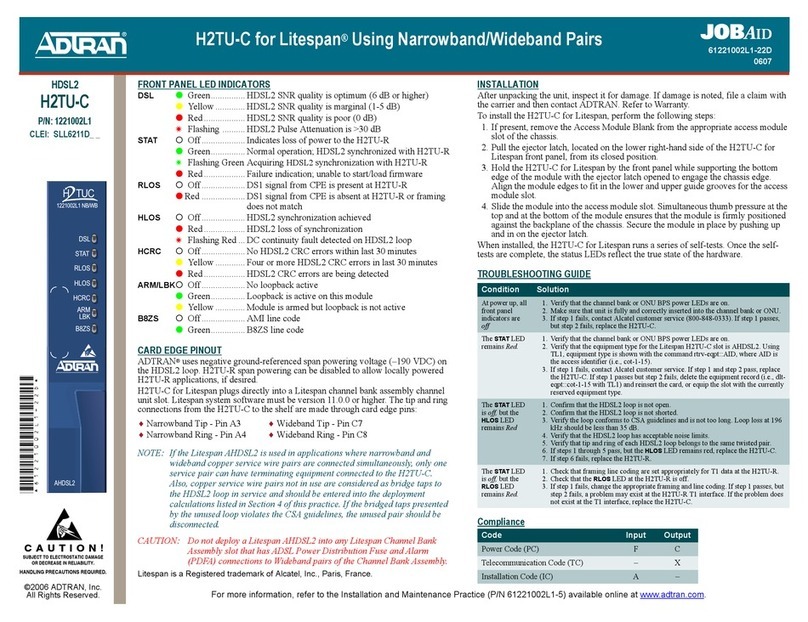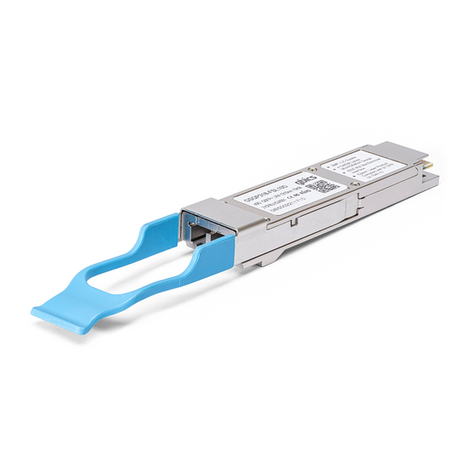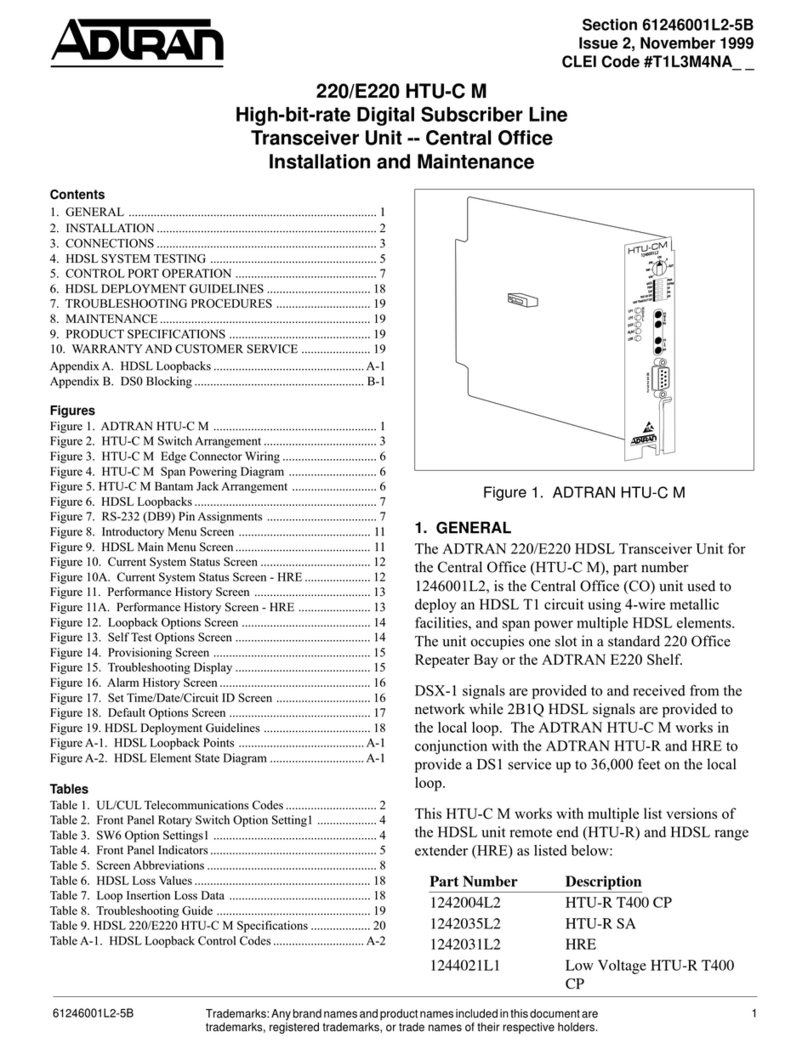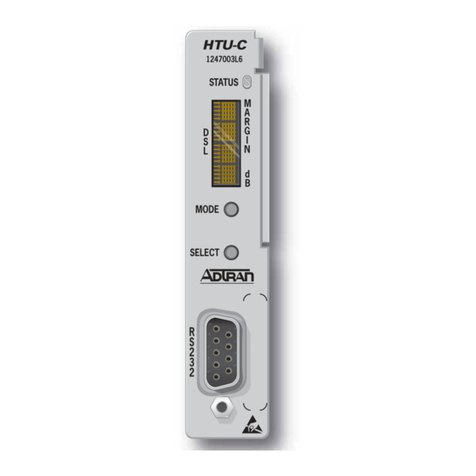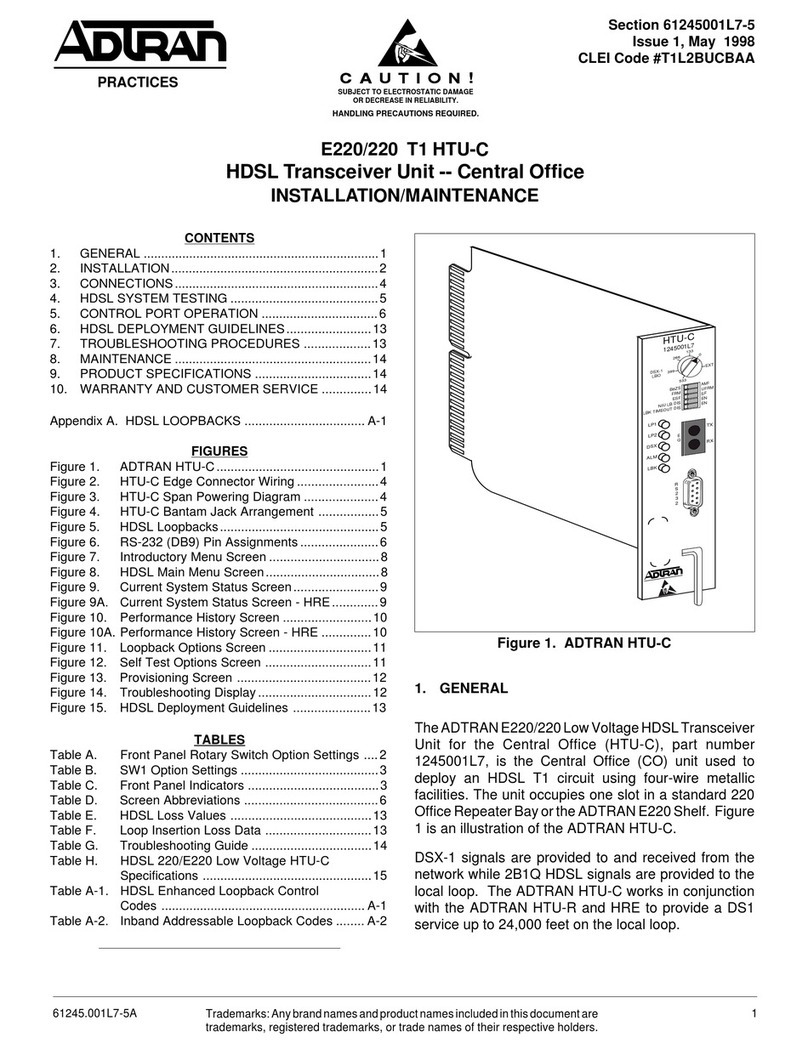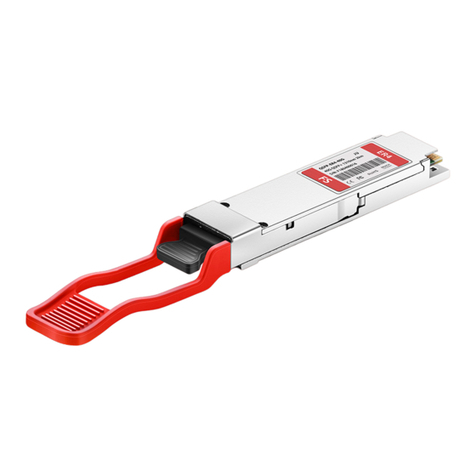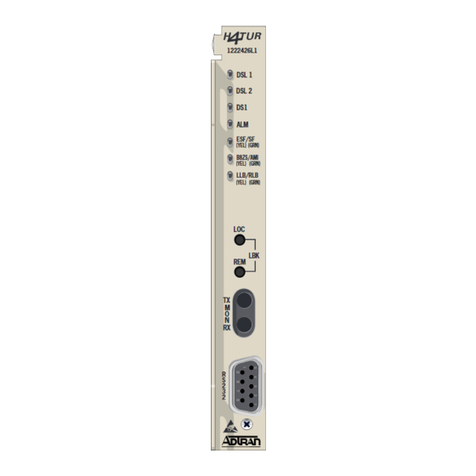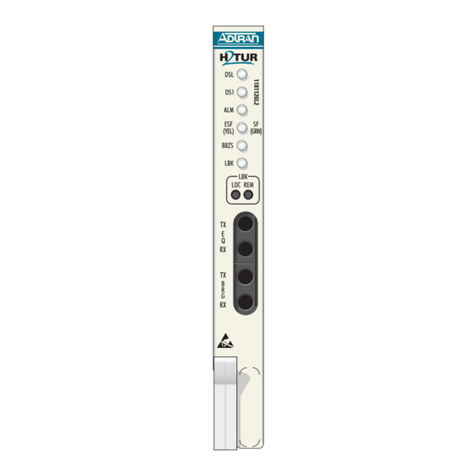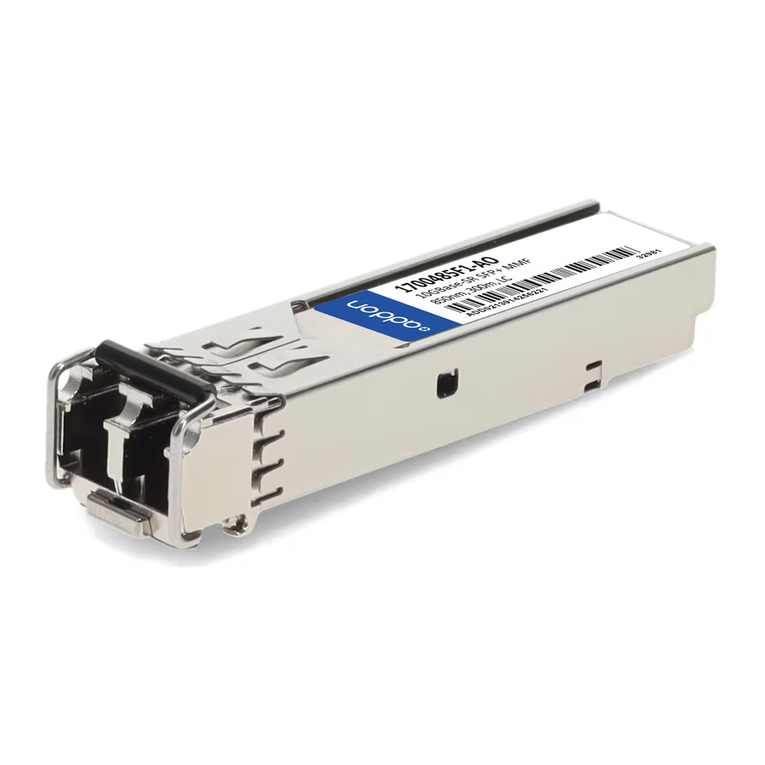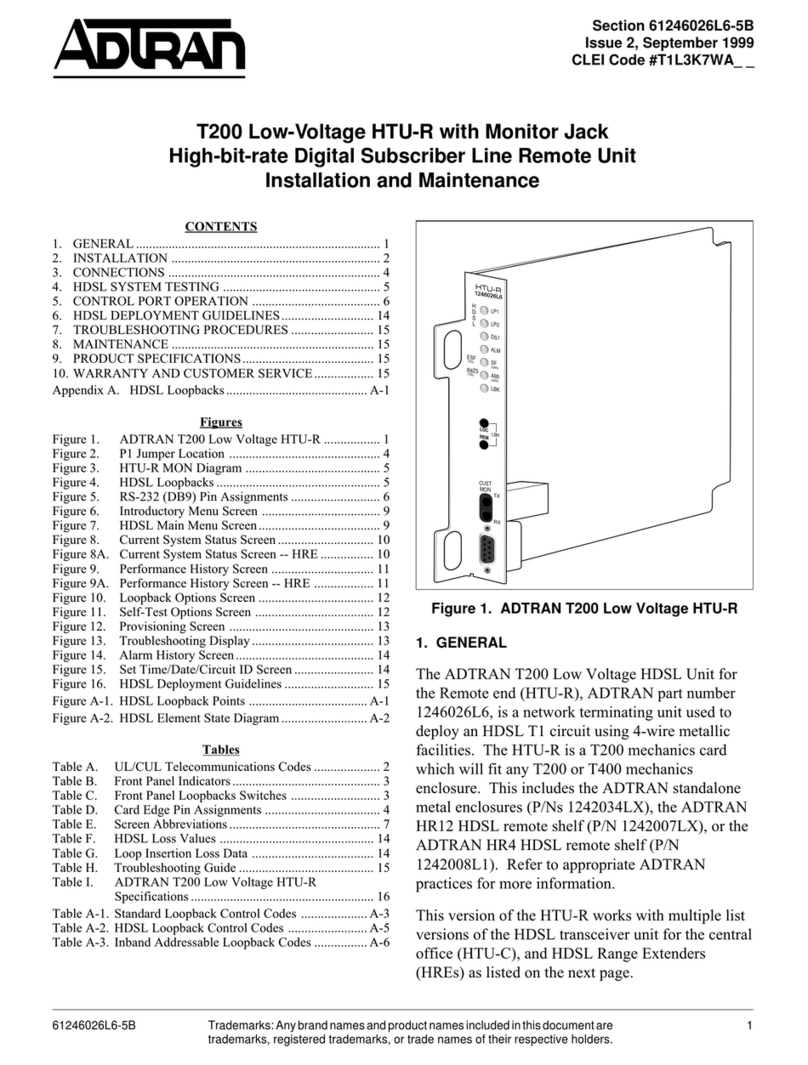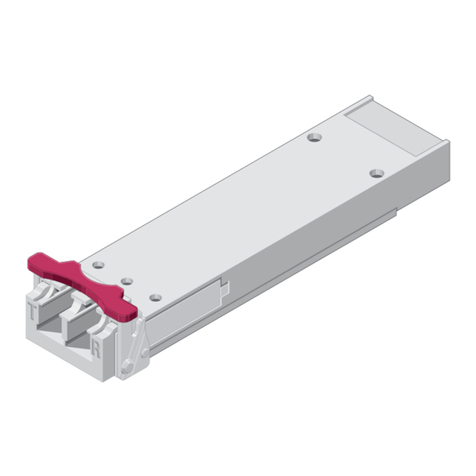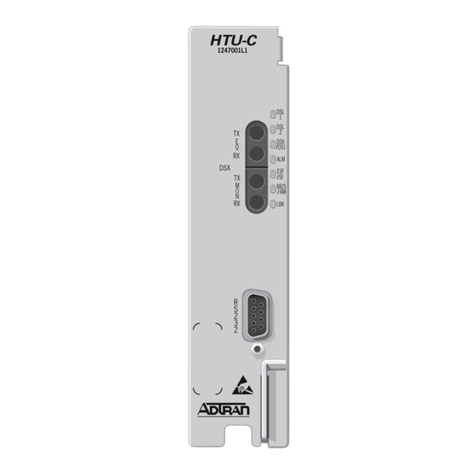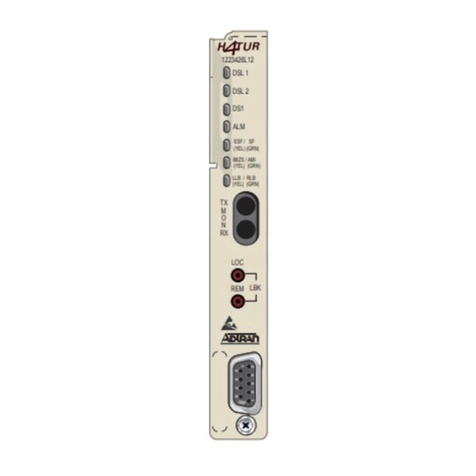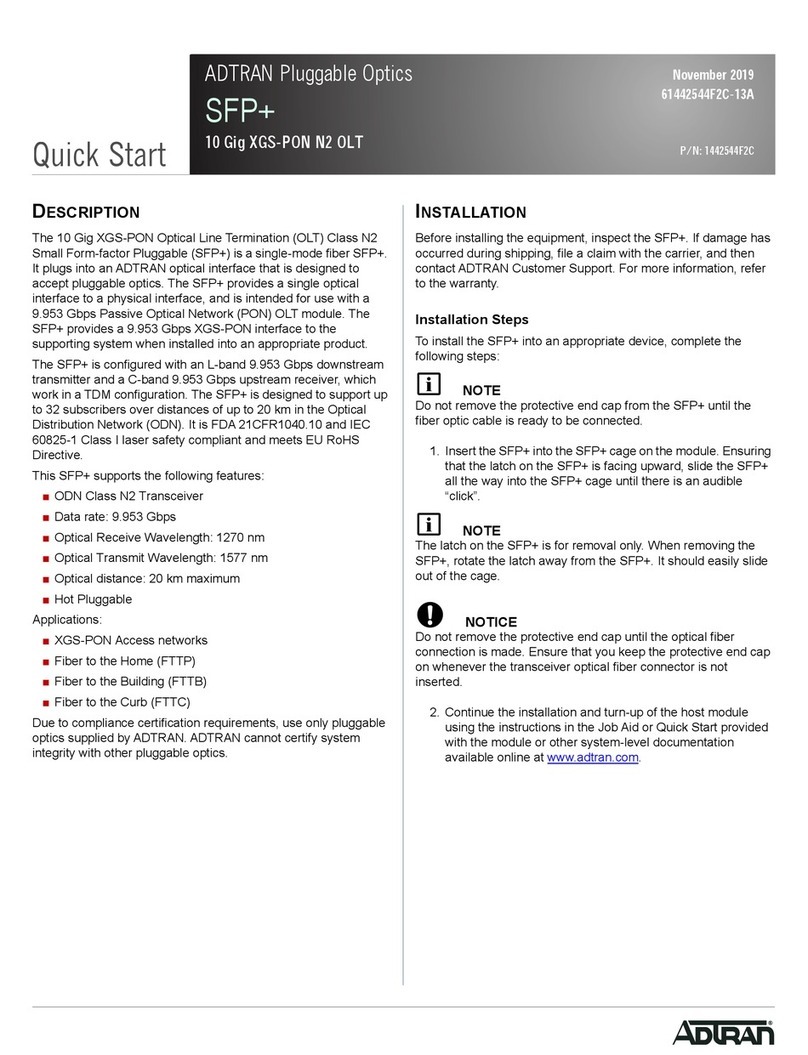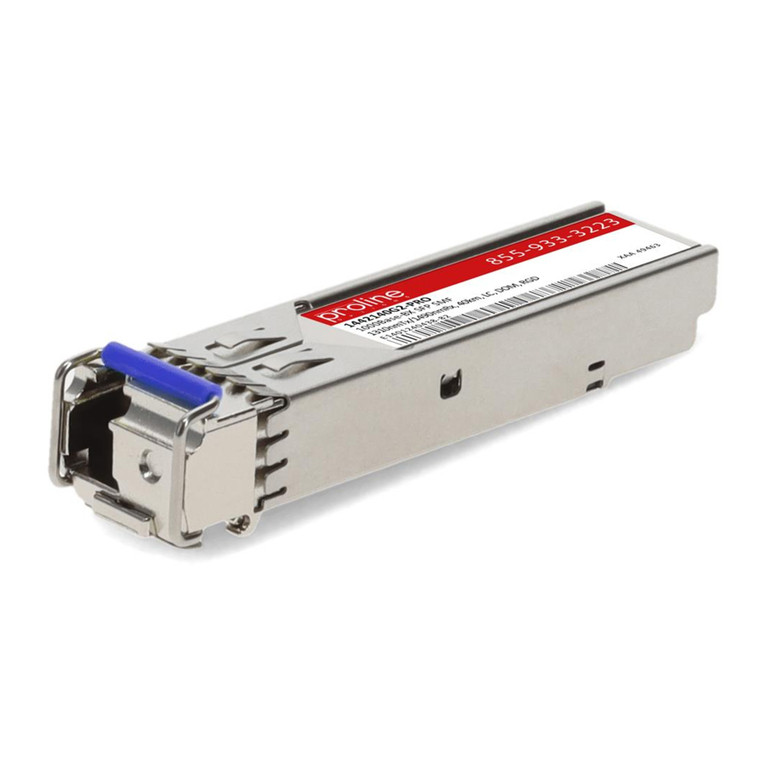
PRICING AND AVAILABILITY 800.827.0807
TECH SUPPORT 800.726.8663
RETURN FOR REPAIR 256.963.8722
www.adtran.com
61221002L2-22E
Warranty: ADTRAN will replace or repair this product within the warranty period if it does not meet its published specifications or fails while in service.
Warranty information can be found online at www.adtran.com/warranty.
PROVISIONING OPTIONS / LOOPBACK FUNCTIONS
On initial insertion of the Litespan H2TU-C into the Litespan system, the H2TU-C is provisioned with
the configuration data stored in the shelf controller. Pre-provision the H2TU-C as indicated under “Pre-
Configuration Value” in the table below. The loopback function codes are shown at right.
1. Some settings may not be available at the H2TU-R.
2. This option is only available if the H2TU-R P/N 1221026L1, 1222026L1, 1223026L1 is used in the circuit.
3. This option is not available if the H2TU-R P/N 1221026L1, 1222026L1, 1223026L1 is used in the circuit.
H2TU-C
Options
Corresponding
Litespan
Parameter
H2TU-C
Available
Setting
Corresponding
Litespan Setting
Pre-Configurable
Value
Line Code LINECDE AMI
B8ZS
AMI
B8ZS
B8ZS
Framing 1FMT SF
ESF
Unframed
Auto
SF
ESF
UNFR
AUTO
AUTO
NIU Loopback NIDLPBK Disabled
Enabled
NO
YES
YES
Loopback
Timeout 1
LBKTMO 0
20 Minutes
60 Minutes
120 Minutes
0
20
60
120
120
DS1 TX Level AT 0
–7.5 dB
–15 dB
0.0
–7.5
–15
0.0
New England
Loopback 1,2
LPBKACTR Disabled
Enabled
0000000000000000
0000000000000001
0000000000000000
Latching
Loopback
FT1MODE T1
FT1
NO
YES
NO
Span Power LP Disabled
Enabled
SINK
SOURCE
SOURCE
Customer Loss
Indicator 3
LPBKDEACTCDE AIS
AIS/CI
Loopback
0000000000000000
0000000000000001
0000000000000010
0000000000000001
PRM Setting LPBKACTC None
SPRM
NPRM
Auto (Both)
0000000000000000
0000000000000001
0000000000000010
0000000000000011
0000000000000001
Network Keep
Alive
NTWKKPALV Disabled
Enabled
NO
YES
NO
Note: All codes listed above must be sent for a minimum of 5 seconds in order for them to be detected and acted upon.
1. The H2TU-C and H2TU-R individually detect and act upon in-band loopback control codes. Depending on which list
number of H2TU-R is used with the Litespan H2TU-C, some of these control codes may not cause action (such as loop up,
error injection, etc.) at the H2TU-R. Refer to the H2TU-R documentation for supported control codes.
2. Modules must be armed with 11000b or FF48h for this code to function.
3. In order to behave like a NIU, the H2TU-R can not loop down from the network side with 9393h.
4. This code can be detected only if the modules are armed OR if any loopbacks are active.
5. If NIU is enabled, then the H2TU-R can be in network loopback when the H2TU-C or H2R loop up codes are sent.
Function/Code Response
1 in 3 (1) (100) Loop down everything
1 in 6 (100000) (1) If armed, Loops back at the H2TU-R toward the network.
4 in 7 (1111000) Loops back data from network toward network in the H2TU-C
6 in 7 (1111110) Loops back data from customer toward customer in H2TU-C
1111 1111 0001 1110 Loops back data from network toward network at H2TU-C (FF1E HEX)
0011 1111 0001 1110 Loopback data from customer toward customer at H2TU-C (3F1E HEX)
Arm/ 11000 (known as
2-in-5 pattern) (1)
Loops the H2TU-R toward the network and arms the H2TU-C. No AIS or errors are sent. When
sent from the customer, this code arms all modules.
Arm/ FF48 (1)
(1111 1111 0100 1000)
This pattern is sent on ESF FDL. When sent from network, all modules are armed and the
H2TU-R is looped back toward network. This code has no functionality when sent from the cus-
tomer.
Disarm/ 11100 (1)
(3-in-5 pattern)
All modules are removed from the armed state and looped down when the 11100 pattern is
received. The LBK LEDs turn off on all modules.
Disarm/ FF24 (1)
(1111 1111 0010 0100)
This pattern is sent on ESF facility data link, and disarms and/or loops down all modules.
H2TU-C Network Loop
up / D3D3 (1, 2)
(1101 0011 1101 0011)
If the modules have been armed and no modules are in loopback(5), the H2TU-C loops up toward
the network, 2 seconds of AIS (all 1s) are sent, 5 seconds of data pass, and then 231 bit errors
are injected into the DSX-1 signal. As long as the pattern continues to be sent, 231 errors are
injected every 20 seconds. When the pattern is removed, the module remains in loopback. If the
pattern is reinstated, the injection of 231 bit errors resumes at 20-second intervals.
H2TU-R Address 20 for
extended demarc
/ C754 (1)
(1100 0111 0101 0100)
When sent from the network, an H2TU-R network loopback is activated and a 200-bit error con-
firmation is sent. 2 seconds of AIS (all 1s) is sent, 5 seconds of data pass, and then 200 bit
errors are injected into the DSX-1 signal. As long as the pattern continues to be sent, 200 errors
are injected every 20 seconds. The HDSL2 office unit does not block transmission of far-end NIU
loopback from the customer premise (H2TU-R).
Loop down / 9393 (1, 3)
(1001 0011 1001 0011)
All modules currently in loopback loop down, but remain in the armed state.
Query Loopback
/ D5D5 (1, 2)
(1101 0101 1101 0101)
If the modules are armed and the H2TU-C or H2TU-R are in network loopback, errors are
injected into the DSX-1 signal upon detection of the query loopback pattern. As long as the pat-
tern continues to be sent, errors are injected again every 20 seconds. The number of errors
injected each time depends on which unit is in loopback. 231 errors are injected if the H2TU-C
is in network loopback and 20 at a time if the H2TU-R is in network loopback.
Query Loop
Parameters/ DBDB (2)
(1101 1011 1101 1011)
If the units are armed and the H2TU-C is in network loopback, errors are injected into the DSX-
1 signal upon detection of the query loop parameters pattern. As long as a pattern continues to
be sent, errors are injected again every 20 seconds. The number of errors injected each time
depends on the current status of signal quality and pulse attenuation parameters on each loop.
111 errors are injected if all HDSL2 receiver points (H2TU-C, and H2TU-R) indicate pulse atten-
uation is 30 dB or lower and signal quality (margin) is 6 dB or higher.
11 errors at a time are injected if any of the receiver points indicate pulse attenuation is greater
than 30 dB and/or signal quality (margin) is less than 6 dB.
Loopback Time Out
Override / D5D6 (1, 2, 4)
(1101 0101 1101 0110)
If the units are armed and this pattern is sent, the loopback time out is disabled. The time out
option is updated to NONE on the PROVISIONING menu of the H2TU-R screens (viewable
through the RS-232 port). As long as the units remain armed, the time out remains disabled.
When the units are disarmed, the loopback time out returns to the value it had before the D5D6
code was sent.
Span Power Disable /
6767 (1, 2, 4)
(0110 0111 0110 0111)
If the units are armed and this pattern is sent, the H2TU-C deactivate the span power supply,
removing power to the H2TU-R. As long as the pattern continues to be sent, the span power
supply remains disabled. When the pattern is discontinued, the H2TU-C reactivates its span
power supply, returning power to the remote unit. All units retrain and return to the disarmed
and unlooped state.
HDSL2
H2TU-C for Litespan®Using Narrowband Pairs
Litespan is a Registered trademark of Alcatel, Inc., Paris, France
